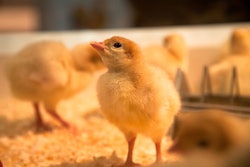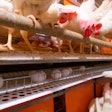
The COVID-19 pandemic added to the U.S. turkey industry’s woes in 2020.
In a WATT Poultry Chat interview, Dr. Thomas Elam, president of FarmEcon LLC, reviewed performance metrics from 2020. He examined how the pandemic’s impact on foodservice demand and reduction of holiday gatherings slowed down turkey in 2020 and provided an early forecast for 2021.
Austin Alonzo: I understand that today you want to discuss the 2020 market and how it was affected by COVID-19.
Thomas Elam: It did have quite an impact. I've got six slides we're going to run through here real quick.
The first one is a chart of total domestic turkey use with exports added in, so it's total turkey disappearance by month. You can clearly see in the solid green line, the seasonal pattern peaking in October, November. The dotted line is a 12 month moving average that smooths out those peaks. So we can see the dip in 2015 when highly pathogenic avian influenza (HPAI) hit. And the dip in 2020 has been almost as severe. And I attribute that largely to a loss of foodservice business that was not made up for by retail sales.
The next slide is turkey production. And again, we have a somewhat seasonal pattern. But there's a lot of monthly ups and downs at that dotted line, which is another 12 month moving average. And you'll see this through all these slides, takes out and we can see the turkey production has been dropping now, since 2018, all through 2019 and 2020. That production was slowly trending downward because the industry is not been in great economic shape. And then we see that reduction accelerate in 2020, because of the disappearance of so much foodservice demand.
If we look at stocks, which is the difference monthly between how much we use and export and how much we produce, we can see this big wave and you can see obviously in that dotted line, which is the actual data, you see a major up and down seasonally. So we have to use a 12 month moving average here on stocks because of the big disappearance in the holiday season around Thanksgiving and Christmas. So what you can see here is those stocks have been coming down, the peaks from 2018 to 2020 are successfully lower, as are the bottoms. And in fact, the November ending stocks were almost record low. They were just as low as they were back during HPAI in 2015. So we've set up for a little bit of a recovery maybe in 2021. If we can get that food service demand back.
If we look at the part stocks, this is the total stocks broken down by USDA categories. What we see is that all of that reduction in stocks has been in whole birds. We've had excess breast stocks now, and breast stocks are higher even than they were back in 2012. So it shouldn't be surprising to see these stocks differences reflected in prices. And yes, they are.
The next slide is frozen whole turkey prices. And what we can see if we think back on the stocks, look at the stocks back here and then look at the prices, these stocks have been going down and the prices have been going up, particularly since 2019 whole bird prices have been going up. The bottom line is feed costs, my estimate of feed costs on a ready-to-cook turkey basis. And we see that spike at the end of 2020 as a result of a corn crop that turned out to be not quite as good as we thought it would be. That did squeeze margins a little bit but we're making money on whole birds.
But we look at parts prices. In this case, the top line for most of the chart is our feed cost. And it's on the right hand axis and the turkey parts prices on the left hand axis. And what we can see here is that parts prices have by and large have been pretty flat. And particularly you see that dip in the red line out there in March, April of this year breast meat prices. Breast meat is a big food service item and when we shut down all the restaurants in the country, you can see what that did to breast prices, and they never recovered.
At best, we're probably breaking even on parts today. And that increase in feed cost out there, that top line, from 28 cents to almost 38 cents. That 10 cent increase in feed costs has just killed the parts profitability. So hopefully those stocks will lead to some recoveries in prices in 2021. And certainly the continued reductions in production will help.
This transcript is edited for length and clarity.
View our continuing coverage of the coronavirus/COVID-19 pandemic.
















